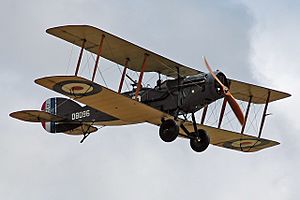Charles Napier (RAF officer) facts for kids
Quick facts for kids
Charles George Douglas Napier
|
|
|---|---|
| Born | 1892 Shepherd's Bush, London, England |
| Died | 15 May 1918 (aged 25–26) Lamotte, France |
| Memorial |
Arras Flying Services Memorial, Pas de Calais, France
|
| Allegiance | United Kingdom |
| Service/ |
British Army Royal Air Force |
| Years of service | 1914–1918 |
| Rank | Captain |
| Unit | Army Cyclist Corps No. 20 Squadron RFC No. 48 Squadron RAF |
| Battles/wars | World War I |
| Awards | Military Cross Distinguished Conduct Medal Médaille Militaire (France) |
Captain Charles George Douglas Napier, MC, DCM (1892 – 15 May 1918) was a British World War I flying ace credited with nine aerial victories before being killed in action.
Biography
Napier was born in Shepherd's Bush, London, England in 1892. Before the war he was employed in the Fire Department of the Employers' Liability Assurance Corporation Ltd.
Army service
He began his military service as a private in the Army Cyclist Corps. In August 1915, while serving as a corporal in the 47th Divisional Cyclist Company, Napier was awarded the Distinguished Conduct Medal. His citation read:
For conspicuous gallantry on the 25th and 26th May 1915, at Givenchy. After the withdrawal of a bombing party, and having become separated from it, he remained in the trenches with a Serjeant and some men of another Battalion, and greatly assisted this small party by the use of his bombs in retaining possession of a captured trench.
On 24 February 1916 he received the Médaille militaire from France "in recognition of ... distinguished service during the campaign".
Royal Flying Corps service
Napier was seconded to the Royal Flying Corps, and commissioned as a temporary second lieutenant on 23 September 1917. He served with No. 20 Squadron in late 1917 before transferring to 48 Squadron in early 1918. He scored his first aerial victory while with them, on 7 February. On 4 April he was promoted to acting-captain. He would run his total to nine wins, rounding off his tally with a triple victory on 9 May; he and his gunner Walter Beales were also shot down during this action, though without injury. Six days later, he was killed in action, shot down along with his gunner of the day. On 12 June, the Germans verified Napier's death. Ten days later, his award of the Military Cross was gazetted, as follows:
On one occasion during a low-flying bombing attack he descended to a height of 100 feet and dropped four bombs amongst a body of enemy troops, causing heavy casualties and scattering the enemy in all directions. Later, whilst on offensive patrol, he observed an enemy two-seater and two scouts. He fired twenty rounds at the two-seater, with the result that it crashed, and then attacked one of the scouts, which turned over completely, and finally went down in a vertical nose dive. In all he has to his credit two enemy machines crashed and four driven down out of control. He has displayed the greatest judgment, determination and daring.
| No. | Date/time | Aircraft | Foe | Result | Location | Notes |
|---|---|---|---|---|---|---|
| 1 | 7 February 1918 ca. 0600 hours |
Bristol F.2B Fighter | LVG reconnaissance plane | Destroyed | Le Catelet | With gunner/observer J. M. J. Moore |
| 2 | 8 March 1918 ca. 0600 hours |
Bristol F.2B Fighter | DFW reconnaissance plane | Set on fire; destroyed | Saint-Quentin | |
| 3 | 16 March 1918 ca. 0600 hours |
Bristol F.2B Fighter | LVG reconnaissance plane | Driven down out of control | ||
| 4 | Albatros D.III | Driven down out of control | ||||
| 5 | 27 March 1918 @ 1120 hours |
Bristol F.2B Fighter (s/n C4886) |
Reconnaissance plane | Destroyed | Southwest of Roye | |
| 6 | Pfalz D.III | Driven down out of control | ||||
| 7 | 9 May 1918 @ 1540 hours |
Bristol F.2B Fighter (s/n C4750) |
Fokker Triplane | Driven down out of control | Wiencourt-l'Équipée-Mericourt | With gunner/observer Walter Beales |
| 8 | Fokker Triplane | Driven down out of control | ||||
| 9 | Fokker Triplane | Driven down out of control |


